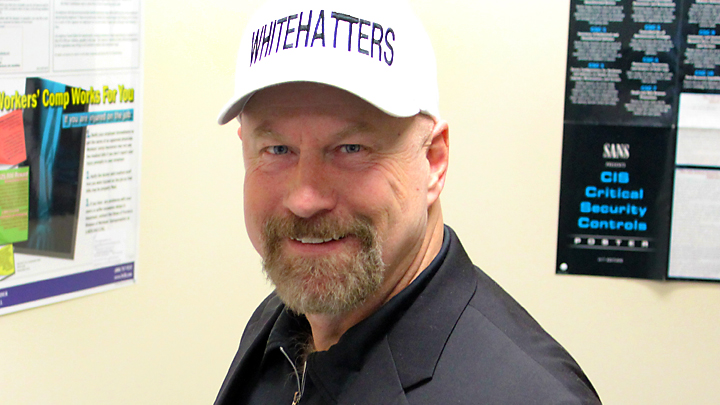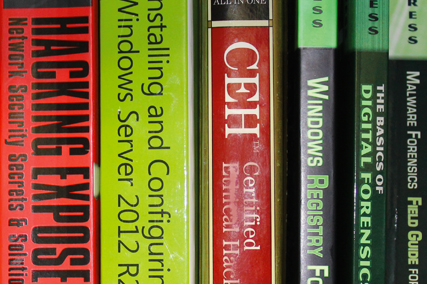Current Features
A Pioneering Warrior
One of the first White Hatters helped launch a new profession
By Joey Johnston, '81

In the wild west of the cyber age, Jeremy Rasmussen is an old-timer who's been riding into battle wearing his white hat for years. A former Eagle Scout (even as a kid he was always prepared) and Jeopardy! champion (he won more than $28,000 in 2007), the 50-year-old is a modern pioneer.
When he began his career more than 25 years ago, cybersecurity as a profession didn't exist. Rasmussen was among those early adopters who foresaw the potential for danger. He developed a curriculum for and taught USF's first course in cybersecurity back in 2000 and co-founded a club to help students develop "ethical hacking" skills.
"Way back when, who thought it would all turn out this way?'' he asks.
Um, he did.
Rasmussen, who received a bachelor's in computer science from USF in 1991 and a master's in engineering three years later, is a partner and chief technology officer with Abacode, a cybersecurity firm that serves growing organizations. The company makes its home in USF Research Park, an entrepreneurial community adjacent to USF Tampa.
"I love it,'' he says. "It's a super exciting field, always on the cutting edge. We
love being associated with USF. Our company can partner with professors and academia.
We can work closely with the best and brightest students and we have hired several
of them.
"We want to help people who feel powerless and give them a strategy to combat this.
This field and this type of work has just exploded in growth. It's so different than
when I was starting out.''
The late 1980s saw the introduction of what is believed to be the first cyber "worm," or virus. While the Morris worm affected internet access around the United States, the impact was negligible because the system had few users. Even by 1995, according to Pew Research, only about 14 percent of Americans had access, most via slow, dial-up modem connections.
While working as a USF adjunct professor and taking graduate-level courses in networking, Rasmussen – perhaps acting on a prescient instinct – asked if any computer security classes were offered.
They were not.


So he developed a curriculum and in 2000, taught USF's first Introduction to Computer Security course.
It was popular from the beginning, but Rasmussen says students mostly viewed it as a cool-sounding curiosity. Hacking into computer systems had been glamorized in Hollywood – Hackers, starring Angelina Jolie, debuted in 1995 – and Rasmussen says he can't be completely certain about the intentions of his original students.
"There was some concern about hacking even back then, but not to the level of today,
obviously,'' Rasmussen says. "I remember in the '90s getting the Michelangelo virus
and it would propagate through the floppy disk. We had AOL; it was just a different
time.
"For the most part, the students wanted to know what they could do to make computers
work for them. They weren't thinking about what they should do to make it safe and
secure. That thinking still existed when the wireless systems were developed. They
really got going before there was a good way to secure them.''
The so-called Black Hatters saw the opportunity for wrongdoing before many early internet
developers saw danger, Rasmussen says.
"People who invented the internet were just trying to bring computers together and
deliver data across a distributed network,'' he says. "They weren't thinking, 'How
do I exploit this for evil? How do I monetize it?' The bad guys got a head start on
this. The good guys have been catching up. And this is a field where things are literally
changing by the day, so you have to stay nimble.''
Far-reaching and sometimes devastating cyberattacks in recent years have heightened awareness of computer vulnerabilities. The Target Corp. suffered a data breach in 2013 that exposed 41 million customers' sensitive information. The retail chain ultimately paid a settlement of $18.5 million.
Last year Equifax, the consumer credit reporting agency, suffered a data breach that exposed the personal information of more than 145 million Americans. Also last year, computers serving hospitals, governments, schools and companies in almost 100 countries saw their information taken hostage and literally held for ransom by a crippling malware attack.
"Just in the last five years, these major data breaches have really made corporations stand up and take notice of the severity of this problem,'' Rasmussen says. "When dollars start getting involved, people notice."
Studies place a value of $150 on a record of private information, he says. That takes into account the potential ransom if it slips into the wrong hands, plus the costs of governmental regulatory fines and judgments from class-action lawsuits.
"So let's say you have 1,000 records at $150 each. You're a small business. Can you survive that kind of damage, especially if you have no plan in place to mitigate any potential breach? You need a plan and we, as an industry, need more and more people who can implement these plans.''
In 2005, Rasmussen co-founded the White Hatters Computer Security Club to help USF students better understand cybersecurity threats and strategies through "ethical hacking." While Black Hatters look for weaknesses in computer systems and networks in order to exploit them, White Hatters hack to identify vulnerabilities that system owners and managers need to fix. USF's White Hatter students had to sign a statement pledging they wouldn't use their new-found knowledge to do harm.
Rasmussen was the club's first faculty adviser and remains involved today. The White Hatters serves as a social group that also helps develop job skills.
"For sure, I wouldn't have the job I have now if it wasn't for the club,'' says Brad Daniels, computer science '17. Last year's club president, he recently started work at a cybersecurity firm in Washington, D.C. "There's a sense of camaraderie and even competition. You're pushed to another level you might not have gone to if you were just sitting around at home, trying to read up on security stuff.
"There are so many intelligent people in that room. When I started, I knew hardly anything. I was kind of astonished at all the things I learned. I would say there were dozens — if not hundreds — of USF students who have benefitted from the club and gotten on an excellent career path.''
That's a meaningful legacy for Rasmussen, who was named the 2017 Tampa Bay Technology Leader of the Year during the Tampa Bay Tech annual awards, which promote and celebrate corporate excellence, individual achievement and programmatic execution in the Tampa Bay area.
Rasmussen has developed curriculum and taught courses for an estimated 2,500-plus undergraduate and graduate students in cryptography, network security, ethical hacking, digital forensics, and mobile and wireless security.
"It's very gratifying for me to have played a small role in influencing this field of study and watching it turn into a career path,'' he says. Rasmussen marvels at the progress digital advances have facilitated – in communications, commerce, general knowledge.
At the same time, he shudders to think about the dark possibilities – people working to hack transportation systems or medical records with malicious intent.
"I don't want to sound sappy, but just like in medicine, you're drawn to helping people, he says. "We do feel like we're the good guys. We're actually trying to solve problems and advance society."